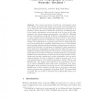Free Online Productivity Tools
i2Speak
i2Symbol
i2OCR
iTex2Img
iWeb2Print
iWeb2Shot
i2Type
iPdf2Split
iPdf2Merge
i2Bopomofo
i2Arabic
i2Style
i2Image
i2PDF
iLatex2Rtf
Sci2ools
ESAS
2004
Springer
2004
Springer
Public Key Cryptography in Sensor Networks - Revisited
The common perception of public key cryptography is that it is complex, slow and power hungry, and as such not at all suitable for use in ultra-low power environments like wireless sensor networks. It is therefore common practice to emulate the asymmetry of traditional public key based cryptographic services through a set of protocols [1] using symmetric key based message authentication codes (MACs). Although the low computational complexity of MACs is advantageous, the protocol layer requires time synchronization between devices on the network and a significant amount of overhead for communication and temporary storage. The requirement for a general purpose CPU to implement these protocols as well as their complexity makes them prone to vulnerabilities and practically eliminates all the advantages of using symmetric key techniques in the first place. In this paper we challenge the basic assumptions about public key cryptography in sensor networks which are based on a traditional sof...
| Added | 01 Jul 2010 |
| Updated | 01 Jul 2010 |
| Type | Conference |
| Year | 2004 |
| Where | ESAS |
| Authors | Gunnar Gaubatz, Jens-Peter Kaps, Berk Sunar |
Comments (0)

